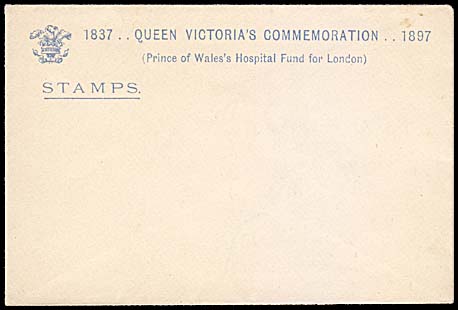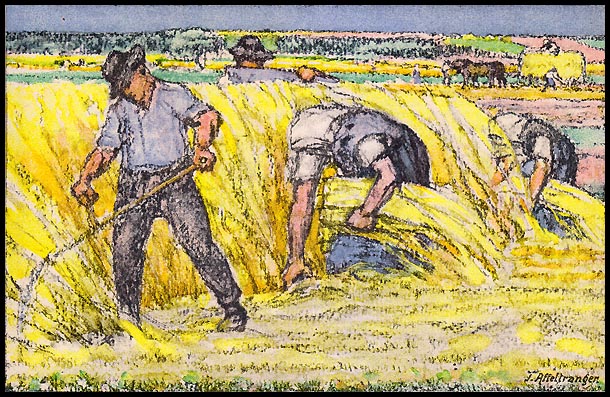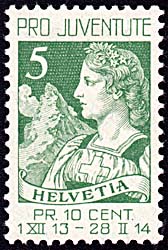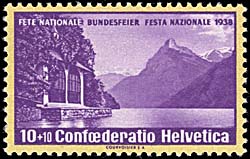The first approaches
In June 1861 in America, a special private organisation - called the United States Sanitary Commission - was established by Federal legislation. Its task was to assist sick and wounded soldiers during the Civil War.
As part of its fund-raising responsibilities, a Sanitary Fair was held in Lowell, Massachusetts on 24 February 1863. Although only a small event, it set a trend for hundreds of similar fairs to be organised throughout the United States during the rest of the Civil War.
| In eight of these fairs, adhesive stamps were available for sale although they were not valid for postage purposes. Instead they were simply collectable items.
Covers without the adhesives but which are directly related to the Sanitary Commission's efforts come on to the market although not regularly. The non-postal stamps are much scarcer. Examples of two of the stamps are shown at the right. |
 The non-postal stamp issued at the Brooklyn Sanitary Fair. |
 The non-postal stamp issued at the Bazaar Sanitary Fair. |
The Great Britain contribution.
Britain had two experiments with Charity issues.
In 1890, a postcard was issued of a semi-postal nature with the aim of raising funds for charity. It is referred to as the "Guildhall Postal Card" and it celebrated the 50th Anniversary of the issue of the first adhesive postage stamp. The selling price for the card was 6d - the balance of 5d being given to a fund for the benefit of postal employees.
| Then in 1897, two Charity poster stamps or seals were issued to raise funds for the Prince of Wales' Hospital Fund. This initiative was in conjunction with the celebrations for Queen Victoria's Diamond Jubilee - 60 years on the Throne.
Although the stamps/seals looked like real stamps, all proceeds raised went directly to the charity. Collectors and donors could apply for the stamps which were delivered in a special envelope. The seals were not to be used for postal purposes although their marketing did confuse the British public. They were printed in sheets of 40 - 8 rows of 5 stamps. |
|
 The seals of 1/- and 2/6 denominations for the Prince of Wales' Hospital Fund. Size (between outside frames): 37 × 32 mm. |
 The small envelope used to deliver orders (size 72 × 107 mm). It underlines the confusion surrounding the seals by using the word "STAMPS". |
The Australian Colonial issues were motivated by the issue of these seals - and bore the same denominations.
Charity (semi-postal) stamps from other countries.
Since the four pioneering issues made by the three former Australian Colonies, many countries have issued semi-postal stamps to raise funds for charity.
| In 1910, Switzerland began an annual practice of issuing postcards to commemorate its Independence Day.
Each year, proceeds were devoted from the sale of these Bundesfeier cards to a named charity - for example to the fight against tuberculosis, to aid the blind, etc. The card at the right is typical of the type of design used. Themes included nationalist images - especially Helvetia - heros and work. |
 1918 Bundesfeier postcard depicting "The Harvesters". One of a series of five postcards issued in that year to raise funds to support Physical and Domestic Education professionals. |
||
In 1912, the use of stamps to raise funds for charity began with the issue of a 10c seal for the Pro-Juventute (Latin meaning "for the children"). The 1912 seal was actually intended to be a stamp but there was no time after the decision was taken to issue a stamp in 1912. All the Pro-Juventute issues were valid for only about three months.
|
Used with a 2c olive-brown Tell's Son paying the special local letter rate on a small Ladies cover |
||
| The use of a stamp was formalised with the annual issues of Pro-Juventute stamps and postcards as from 1913 (see Hall (2010)).
Switzerland's 1913 first Charity stamp (at right) cost 10c - 5c local letter rate and 5c for Charity. The period of postal validity is noted at the base. |
 |
The Bundesfeier postcards for the National Day as shown above were replaced by the Pro-Patria issues from 1938.
|
 One of the two stamps of the first issue is shown above. The cost is shown as 10c postage and 10c for the nominated charity. |
 with 1912 PJ.jpg)